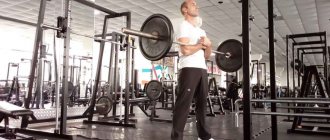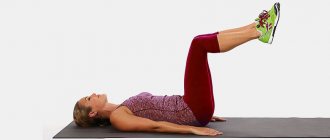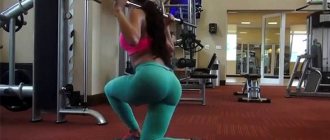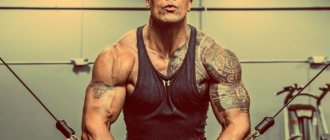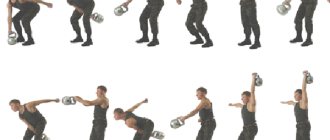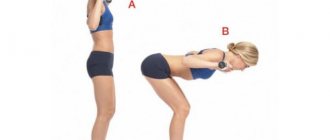The fold or simultaneous twist is a popular gymnastic exercise for developing the rectus abdominis muscle. It is isolating in nature and imitates the movement of simultaneously lifting both legs and body, which is quite rare in everyday life. The fold is done both in fitness and in crossfit, gymnastics, and dancing. The movement is used quite rarely in powerlifting and weightlifting, this is due to the specifics of load distribution and the inability to ensure progression of working weights in movement. We will look at the classic version of twisting on the floor, from a lying position
Execution technique
Initial position
- The exercise is performed on the floor, lying on a mat;
- It is necessary to lie down so that you can gently stretch your spine and press your lower back to the floor as much as possible;
- The athlete lies on the mat; if there is discomfort in the lumbar region, it is permissible to place the hands under the buttocks, with the backs of the palms facing up;
- At the start, the abdomen needs to be pulled inward a little to ensure rigidity;
- The exercise is performed while exhaling.
Movement
- The lifting should begin while exhaling, the athlete simultaneously stretches his legs towards the body, and the body towards his legs;
- The movement is performed with straight legs and a twisted body;
- Resembles hip flexion;
- Exhale with effort, while inhaling the athlete lowers to the floor;
- A lighter version of the fold is performed with bending the legs at the knee joints and bringing the hips towards the stomach;
- Another easier option is for the athlete to place his arms bent at the elbow joints behind his back.
The fold is an abdominal exercise. Technique + error analysis.
Attention
- The exercise is a twisting exercise, the back should not be straight, the goal is to bring the lower ribs to the pelvic bones;
- Lifting your legs too high is wrong. The main movement is performed by the body, and not by the legs;
- A jerking style of execution is not allowed; you should work smoothly and slowly, raise your legs and body calmly;
- There is no need to push the anterior abdominal wall forward;
- It is not recommended to push your chin forward;
- You should bend your legs slightly at the knees, but not to a right angle, unless you want to make the movement easier. You can lower them completely to the floor only if you do not feel discomfort in the lower back.
Benefits of exercise
The thing about the scissors exercise is that it is an incredibly simple yet highly effective all-around movement. It is relevant in all training programs, and due to its universal nature, it can be performed in any conditions.
Main advantages:
- Great benefit for the abs, as it loads almost all the abdominal muscles equally.
- Loads the legs, allows you to reduce the fat layer and tone the muscles.
- Can be performed in any conditions.
- Does not require special equipment.
- Suitable for men and women of any age.
Despite the fact that the exercise is included in the school physical education curriculum, you should not perceive performing scissor kicks as a childish movement. Even trained athletes find it quite difficult to perform this exercise.
Benefits of scissoring exercise for women
It is generally accepted that exercise is mainly beneficial for women. It simultaneously works the hips, buttocks, and the entire abdominal area. Scissoring your legs allows you to narrow your waist, making it an ideal solution for creating an hourglass figure.
Key benefits for women:
- Strengthens the pelvic floor muscles.
- Visually narrows the waist.
- Reduces fat and strengthens the abs, with an emphasis on the lower part.
Benefits of scissoring exercise for men
Apart from the general benefits of exercise, the main benefits for men lie in two aspects:
- Improving blood circulation in the pelvic organs is the main prevention of prostatitis and other diseases of the genitourinary system.
- Strengthening the lower abs, creating a powerful “shield” that will help avoid bulging hernias when working with heavy weights (deadlifts, bent rows, etc.).
Also very useful is that this exercise, unlike most others (except crunches), does not overload the lower back.
Recommendations
- This exercise teaches you to concentrate on the moment of peak muscle contraction. If you don't feel the twisting, you should start with a simpler option;
- The movement should be performed smoothly not only during the ascent phase, but also during the lowering phase. It is worth controlling the lowering so that the muscles do not immediately relax completely;
- It is incorrect to perform the exercise by pushing the head with your hands. Concentrate on working your abs;
- The legs should remain slightly bent at the knees; only very flexible people can afford absolutely straight legs like those of athletes in rhythmic gymnastics and the fitness category;
- It makes sense to perform the movement on a soft and thick rubber mat; yoga mats and mats will not help here;
- It is advisable to wear high-waisted sportswear and non-slip T-shirts to avoid skin damage
Preparatory exercises before the “Fold”
It is sometimes difficult for beginners to perform seated leg raises correctly the first time. Many people complain of lower back pain or rapid fatigue in their legs. This is normal, but it is better to prepare your body for such a load with preparatory exercises.
Eg:
- Lie down flat on a flat surface, bend your knees and lift them vertically in relation to the floor. Now, with your hands folded at the back of your head, raise your body to your feet.
- You can simplify this exercise by lifting your legs one at a time. Try to lift your body smoothly, without making sudden movements.
- The duration of getting used to this exercise is 10-14 days.
After the course, your body will become more obedient and your muscles elastic.
After some time, you can easily master the classic seated leg raise.
Execution options
- “Half fold” - lifting the legs with lifting the body from a fixed position, in which the forearms are on the floor, and the top of the rectus abdominis muscle is brought up only statically;
- Fold on an inclined bench - on the contrary, the body is lifted from a position in which it is tilted back; Fold with rubber shock absorber, additional resistance of the shock absorber when lowering allows you to load the muscles more;
- A curl with dumbbells or other weights is one way to increase the load. It is recommended to take the dumbbells in your hands rather than hang the weight on your feet;
- Fold on a gymnastics bench. This option differs in that the athlete performs an imitation of the movement on the floor, sitting on the pelvis on a bench. He lowers his legs to the floor, and his body too, to achieve a full stretch of the abs, and then rises up again.
How to do the fold exercise correctly
Lying leg raise exercise technique
The classic lying leg raise for the press is performed mainly on a horizontal bench or on the floor. This is a more complex option, although it has maximum efficiency.
Execution technique (classic version on a horizontal surface):
- Lie down on the floor or bench. Use your hands to grasp the edge to secure the body (while lying on the floor, hold your hands along the body or grab any surface above your head to stabilize the body). Bring your legs together and lift them so that there is a right angle at the hip and knee joints.
- Begin to slowly and without jerking your knees towards your chest, bending your pelvis. At the peak point, exhale and hold for 0.5-1 second.
- Return your legs to the starting position and repeat the movement without relaxing your abs.
There is also a more advanced version of raising your legs up. It is considered more complex, but additionally works some of the muscles of the pelvis and hips. This option has two phases of movement. The first begins in a lying position (with your feet on the floor). After this, the knee is bent and the hips are then brought to the chest, as in the usual version. Returning to the starting point occurs in reverse order. It is best to do this leg lift while lying on a bench so that your legs are suspended.
Analysis of the exercise
What muscles work
Main muscles:
- The rectus abdominis muscle allows you to twist;
- Obliques – turning the body;
- Transverse – abdominal retraction
Accessory muscles:
- Additionally, the quadriceps, iliacus muscles, forearms and back work.
pros
- Available to those who do not have any equipment and who practice at home;
- Simple enough to learn on your own, does not require much technical skill;
- Allows progression when crunches are easy;
- Helps to get strong abs, especially for team sports, running, and other applied disciplines;
- Helps diversify training
Minuses
- A fairly complex exercise for people with pelvic displacement and hyperlordosis;
- Does not allow for significant progression if the athlete is involved in strength sports;
- May be ineffective if the athlete has overdeveloped quadriceps;
- Does not give the desired effect if the technique is careless;
- Not recommended for people with back injuries;
- Cannot be performed with diastasis of the rectus abdominis muscle
Preparing for the exercise
First you need to understand how to perform any twisting. Stand straight, point your lower ribs towards your pelvic bones, and twist completely. You will feel the tension in the rectus abdominis muscle exactly as needed. Twisting in this regard will help you understand how to work your abdominal muscles.
Before the fold, it is better to do a general aerobic warm-up if you are not going to do a full set of strength exercises yet, or just start it at the end of your regular workout.
Sometimes it is recommended to do several sets of simple straight abdominal crunches as a warm-up.
Proper execution
- The most direct analogy here is with classic crunches. The body should twist with the lower ribs towards the pelvic bones, and not just flexion and extension at the hip joints;
- You should not pull your head forward with your hands and perform the exercise due to this;
- It will be better if you learn to do the exercise with your legs as straight as possible and do not bend your knees too much;
- Beginners can do bringing the knees to the chest, but this is not quite a fold, but a lighter version of the exercise;
- The movement is based on twisting, and not on lifting the legs, although the movement of the body and legs should be simultaneous;
- You should actively engage the transverse abdominal muscle and pull your stomach inward so that the twisting is as complete as possible;
- The exercise must be performed by statically straining the abdominal muscle, and not twisting at random, and making movement solely due to inertia. The exercise is not performed for a number of repetitions;
- Touching your feet with your palms helps you twist as much as possible in this movement, but this technique can be missed if you can’t fully reach your feet without turning on the force of inertia
- The legs need to be extended, but a slight angle in the knee will protect the popliteal ligaments from injury;
- At the point of maximum twisting, the athlete sits, as it were, on his buttocks, and remains in this position for as long as possible;
- Lifting should be done by contracting the abdominal muscles, and not by doing a set of swinging from a lying position. If there is swinging, the abs are still too weak to work out in this position, and you should look for another load option, a simpler exercise;
- You need to remember the rhythm of breathing, exhale with effort, inhale with lowering. Holding your breath while performing abdominal exercises is not recommended.
V-UPS (The best ABS exercise)
Errors
- Lifting with fully straightened legs and pointed toes;
- Flat back, no twisting phase;
- Work due to inertia alone;
- Incomplete amplitude - the athlete does not reach the buttocks and does not twist, but simply tries to lift his legs and body;
- Legs fully bent at the knees
Efficiency Tips
- Twisting can be made more difficult by holding a small weight in your hands. Yes, then it will not compare with crunches on an incline bench, or the “prayer” exercise in terms of resistance, but it will increase the load;
- If you do not completely lay your shoulder blades on the floor and do not completely lower your pelvis, the exercise will be more effective, since then the muscle will constantly remain in a state of static tension;
- The negative phase of the exercise can be slowed down, and thereby improve the quality of muscle contraction;
- The movement can and should be performed after preliminary fatigue of the leg muscles; this will help not to “work” with the quadriceps. In this regard, combining leg training with a “fold” at the end will have a positive effect
"Fold" for stretching
This exercise is performed not only to develop the abdominal muscles. It is leading to the longitudinal twine. Therefore, the “Fold” stretching exercise is used by gymnasts, yogis and other training people.
Its goal is to develop the hamstrings. However, in addition to it, the muscles of the back and buttocks also work.
Initial position: sitting on the floor. Legs extended in front of you. Knees point up. The feet are pressed against each other. Straight back and relaxed shoulders.
Sequence of actions when performing the exercise:
- First of all, you need to straighten your back. From the starting position, try to stretch the top of your head as high as possible. In this case, the chest and lower back bend slightly forward. Gently, on your hands, rise up. Try to point your heels forward and your tailbone up.
- Bend over slowly, but never lie down completely. Bend over so that your stomach rests on your thighs, without lowering your chest. Arch your hips. Place your stomach from its lowest point. Stay in this position for a few seconds. Let your body get used to it. Hands should be on your knees. However, you should not strain them and try to pull yourself down.
Undoubtedly, everyone now wants to reach their chest to their knees, clasp their feet with their hands and congratulate themselves on a small victory. And, as you already guessed, this is not worth doing. Because this is how another exercise is performed - to round the back. It is also useful, but at the moment our goal is to stretch the hamstrings.
For the Fold, the tilt is accomplished by lengthening the spine rather than rounding. The goal is to place your chest behind your knees, not on them. That is, you need to stretch forward. Over time, everyone succeeds. There is a joke of sorts: you can't put your chest down until you have the chance to bite your big toe. You need to try to stretch as you exhale. The maximum number of repetitions is 10. On the last exhalation, stretch as far as you can forward, and then slowly come out of the position.
You should try to do several types of “Folds” in one workout.
Exercise options
Depending on the level of training, a person performs the exercise options available to him. To do this, there are several types of “Folds” difficulty:
- Dynamic. This type perfectly warms up the muscles. Take your starting position. Stretch your head up. Raise your hands and then place them on your hips. Now make gradual bends, lowering your stomach to your feet. To start, do slight inclines. Gradually going deeper and not rising to the starting position. Do about thirty times to warm up your muscles.
- Reverse. The initial position is: the body resting tightly on the hips. The legs are bent. Hold your feet with your hands. Now gradually straighten your legs. Do this slowly so you can get used to the new position. This “Fold” does not strain the muscles so much.
- Socks from myself. It is better to start the “Fold” exercise and get to know it with this option. Since with the toes extended away from you, there is less load on the popliteal fossae. That is why this option is easier for beginners.
- Socks on yourself. Accordingly, this option is more complex. Since now the popliteal fossae are already included. They tell us about this with nagging pain. The main difference from the previous version of the exercise is that your toes should be directed towards you.
- With weight. Here you will need the help of another person. This option assumes that we will be pulled with the help of a partner.
- With support. A more complicated option for those whose body fits perfectly on their feet. Gymnastic cubes or rollers are placed under the heels. And your partner gently presses on your back. This option will allow you to stretch your knees perfectly.
Common Mistakes
When performing exercises, a person sometimes does not notice the result. This is due to incorrect execution technique. The most common mistakes include:
- neck pressed into shoulders;
- back “wheel”;
- knees turned outward;
- improper breathing;
- an overly tense state;
- incorrect placement of the feet;
- legs bent at the knees.
All these moments should be controlled, since the result is built from such little things. The more mistakes made, the less effective the training.
Inclusion in the program
The inclusion of a fold depends on how prepared the athlete is and what his goal is. For those who develop endurance for athletics or cyclic sports, it is recommended to perform the fold in a multi-repetition mode, increasing the number of repetitions to the maximum possible.
For those who exercise simply for health and beauty, we can advise you to do the exercise in a mode that is comfortable for yourself, and not to do too much repetitive work.
The movement can be done as part of a separate ab workout if you need it, or as an exercise at the end of a regular strength training session. The fold is extremely rarely done as a warm-up exercise.
You can do a fold, alternating it with other exercises, or replacing more familiar abdominal movements with it.
Exercises for the abdominal muscles
When it comes to bodyweight exercises, crunches aren't the best way to tone your abs. Recent research has shown that crunches are not as effective as they are believed to be because they do not activate all of the core muscles.
So, if you want to improve your strength, such as being able to do better pull-ups, or want to get those 6-pack abs, there are more effective exercises than endless crunches.
From plank variations to weight-based exercises, the exercises below completely change the way you train your core. You don't even need to concentrate on tensing your abdominal muscles. Working according to this method, the abs muscles are included in the work in full.
How it works
Circular training. Depending on your level of physical fitness, choose 2 - 3 most suitable exercises for yourself (1 circle).
We perform each exercise for 60 seconds (or the number of repetitions indicated in the description).
We rest for 20 seconds and perform the following exercise.
We perform the selected exercises, rest for 60 seconds and repeat the circle.
You need to do 3 or 4 circles.
Bodyweight exercises
Exercises while standing
The most popular stretching exercises are usually difficult to perform, so you should start training with simple stretches for the splits.
You can do the following exercises while standing:
- swing your legs (forward, backward, to the sides) - you can perform the exercise by leaning your hand on a wall or chair. If it works without support, even better;
- body tilts - you need to place your feet shoulder-width apart, grab your elbows with your palms and bend down as much as possible. Try to touch your chest with your thighs;
- side lunges - spread your legs wide, cross your arms over your chest. Perform smooth lunges from one side to the other;
- bridge against the wall - stand against the wall, raise your arms up and place your palms on the wall. Slowly lower your body back, helping yourself with your hands. You may not be able to get down on the floor the first time; the main thing is to avoid discomfort in your back.
Ab exercise “fold” – variations on the floor and bench
The material was prepared by the site team with the support of our experts: athletes, coaches and nutrition specialists. Our team >>
- Reading time: 4 min.
- Muscle load
- If the goal is weight loss
- Fold technique
- On the floor
- On the bench
- Lead-up exercises
A rather complex and effective exercise for the entire rectus abdominis muscle is the so-called fold. In appearance, the movement resembles double crunches, with the difference that you reach with straight arms to straight legs, and the buttocks are the fulcrum. During the movement, the body takes the form of the Latin letter V. The advantages of the fold exercise are that it allows you to maximally load the abdominal muscles without overstraining your back.
Muscle load
Of course, when performing a fold, the entire rectus abdominis muscle (both lower and upper parts) actively works. Therefore, performing a fold can replace traditional crunches, which mainly load the upper abdominal areas, and lying leg raises (or reverse crunches), which shift the load to the lower abdomen.
In addition, the exercise loads the oblique abdominal muscles, which in any case will work simultaneously with the rectus abdominis muscle. At the same time, the load on them in this exercise will not be as intense as, for example, with the addition of torso rotations in lateral twists.
According to the residual principle, the hip flexors and quadriceps muscles of the thighs (quadriceps) are included in the work.
In order to not only effectively pump up muscles, but also to reduce excess weight, it is necessary to add cardio (aerobic) exercise to strength training. This will speed up the delivery of excellent results. The waist circumference will decrease, the stomach will become flat and toned.
In order to maintain the results you have achieved in the future, you need to continue a healthy lifestyle, which includes physical activity (at least 3 hours a week) and a proper balanced diet.
Diagnostic methods at home
What could a rash cause in a baby?
At home, parents should periodically check:
- Examine the legs in the groin and knee areas for lack of symmetry;
- Assess the bend of the limbs, it should not be different;
- There may be deeper folds on one of the legs, this should be reported to the pediatrician;
- Placing the baby on his tummy, if he is capricious and wants to change position, this may indicate the presence of dysplasia.
How is dysplasia treated in newborns?
What else should parents be wary of:
- asymmetry of the gluteal and femoral folds;
- different lengths of the limbs, when bent - one knee is higher than the other;
- it is impossible to separate two legs (bilateral dysplasia) or one of them (unilateral dysplasia), that is, one leg almost fits on the table when spreading, but the other cannot do this;
- When spreading the legs, a click is heard in the hip joint.
Additional Information. In Russia, according to data, hip dysplasia occurs in 2-3% of cases. In environmentally polluted places this level increases to 12%.
How to make your abdominal workout more effective
Twisting with legs raised belongs to the category of lead-up exercises. This is a lighter version of the fold that will prepare the athlete to perform the basic version. While performing it, you need to keep your hands on the back of your head and your legs in weight. Then, smoothly bend your knees and pull them towards your chest, while simultaneously moving your body forward.
Crunches with raised legs are more suitable for those who cannot train at full strength due to insufficient development of motor coordination and balance. A simplified version of the book can be used to complete a workout on the abs - to finish off the main muscles that were worked on during the training.
The preparatory exercises include variations of the fold with stretches. They are close to the standard version of the book. Traditionally, stretching is performed at the very beginning of working on the abdominal muscles. It develops flexibility and allows you to gradually increase the complexity of the load. Lying stretches are done in this way:
- Lie on the mat, raise both legs in front of you and bend them slightly at the knees.
- Stretch both arms behind your head, while pressing your lower back to the mat, your hips should be at right angles to the surface.
- Without moving your legs, round your back, and then raise your arms, reaching your toes with your fingers.
- Return to the original position without jerking and repeat the movements without lowering your legs to the surface.
If you wish, while preparing for a more complicated version of the fold, you can do the exercise not with both legs at once, but with each leg in turn. To improve flexibility, it is advisable to complete each workout with a stretching block.
After mastering the preparatory exercises, and then the basic folding technique and its variations, you can complicate the training of the abdominal muscles. To do this, you should use various weights - for example, hold dumbbells or a barbell in your hands. Abdominal training with additional weight helps you get those coveted abs - of course, if the fat layer on your stomach is minimal.
It is necessary to take into account that the book does not load the oblique muscles so much. And if the goal is to strengthen them, then oblique crunches should definitely be included in your abdominal training. The fold goes well with leg raising exercises. For beginners, it is advisable to add three types of load on the target muscles to the complex, and for more experienced athletes - five or six.
Photos used from Shutterstock
You read a lot and we appreciate it!
Leave your email to always receive important information and services to maintain your health
Exercises while sitting
While sitting, you can also do several high-quality exercises that will help you stretch and relax:
- Feet spread - sitting on your knees, spread your feet to the sides without moving your knees. Then sit in the space between your feet. Stay in this position until the tension in the hips increases.;
- “Butterfly” with an inclination - the “butterfly” exercise is performed by all gymnasts and dancers. To perform, you need to sit on the floor and connect your feet to each other. With your knees spread apart, lower and raise abruptly, feeling the tension in the inner thigh. Then deeply tilt your body forward and hold.
- Raising your legs while sitting is not an easy exercise, but it is effective. You need to sit down and stretch your legs in front of you. With both hands, take one foot and slowly pull it up.






